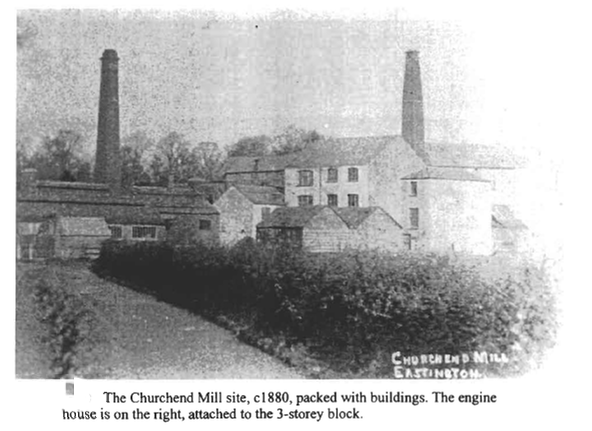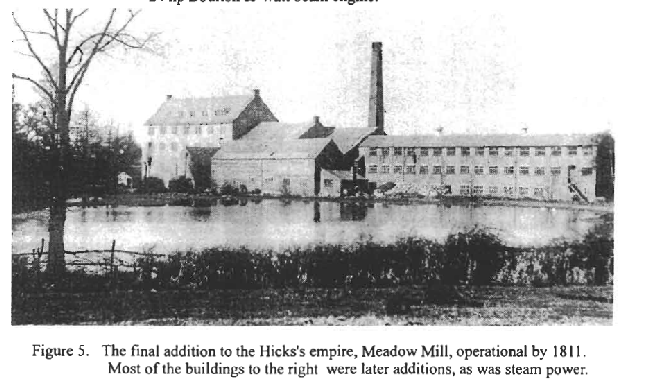



In the same year, he bought the estate of Henry Stephens, along with the manorial rights. The position of Lord of the Manor was to later prove useful in a number of ways.
By 1820, Henry had been joined in the business by his two sons, James Phillimore and Henry Purnell Hicks, and "H. Hicks & Sons" were adding steam engines to their Eastington mills. By now, they were also operating Bonds Mill, just over the parish boundary in Stonehouse, where they installed a further engine. The period c1810-
As his wealth increased, Hicks decided a new family residence was in order and c1815, built The Leaze, to which he added a large park, a short distance from his mill at Churchend. [This was on the site of the original building, Eastington Manor, which had been demolished in 1778.] Along with this, he systematically bought up adjoining land until eventually, he owned much of this area of the parish.
Churchend was formerly linked to the Stonehouse-
Despite the fact that much of his wealth was generated through the efforts of his workers and his mills, Hicks apparently did not wish to be reminded of them from his new house and during the construction of a new chimney stack at Churchend Mills, the height was reduced so that it would not be visible from The Leaze. Likewise, a tall screen of trees was planted along the southern edge of his estate, effectively hiding Bonds Mill from his view.
There was a peculiar happening at the house in December 1829, a period of great economic hardship and social unrest in the countryside. A group of sixteen ‘poachers’ came to the house and shot tame pheasants that Hicks had trained to wander about on the front lawns. When Hicks came to the front door to investigate the noise, the poachers continued shooting and dared anyone to stop them. This act was clearly not about poaching, but a symbolic act of protest about worsening living conditions in the countryside. It was also a show of strength in front of a landowner and obviously meant to be intimidating, despite the fact that those involved made no specific demands of Hicks nor aired any general grievances.
Although Hicks seems to have remained fairly remote from his workforce, he nevertheless made some contributions towards their spiritual and other needs. For instance, he paid for the clock for the tower of St Michaels church (although this may have been his way of ensuring that his workforce at Churchend Mills would not be late for work!). Although there was a gulf between Hicks and his workers, he does not appear to have been deliberately antagonistic as were some of the other masters.
In a time when philanthropy and business went hand in hand, he contributed in a variety of ways to the well-
Although the quality of the cloth produced in Hicks' mills was never in question, in March 1835, the business failed. Overall, the decade was not to be a good one for the Hicks family, as apart from the failure of the business, a spate of deaths occurred. Charlotte Hicks, Henry's wife, had already died in May 1832, to be followed in June 1836 by Hicks himself. The Hicks had previously lost one son in 1824, when Winchcomb Henry Hicks died at the tender age of 21, and in the same year that his father died, the eldest son, John Phillimore, also passed away.
Immediately following this troubled period, the estate was split up amongst the other members of the family. Part of the estate passed to Eliza Phillimore-
NOTE: This article, as it appeared in ECN magazine, was Steve’s own precis of his full length article entitled ‘THE RISE AND FALL OF HENRY HICKS, CLOTHIER OF EASTINGTON’ published in the Gloucestershire Society for Industrial Archaeology Journal for 2002 pages 19-
Click here to see the full article

Stephen Mills
Published in ECN 117 Sep/Oct 2009
At its peak in the 19th century, Eastington became a thriving mini mill town, with virtually all of its social and industrial life inextricably bound up with the woollen cloth trade. Much of this industry’s development during the first half of the 19th century occurred as a direct result of the influence of the Hicks. For several generations, they came to dominate virtually every aspect of village life.
The Hicks family formed an offshoot of the notable Cotswold Hicks-
His initial efforts were focused mainly on the existing Churchend Mill, which by around 1806, he had substantially rebuilt and enlarged (it stood immediately behind the school and was demolished c1912).


The Hicks Family
The History of Eastington Park ( ‘The Leaze’)

